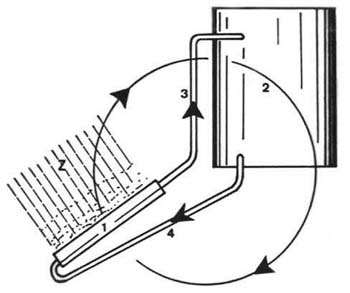Water heating
There are two usable forms of energy to convert the radiation of the sun into: heat and electricity. Electricity is generated using photovoltaic systems (PV systems). More information about these systems can be found here.
The conversion of radiation to heat occurs with a so-called collector. Solar collectors are roughly divided into two types: concentrating and non-concentrating. In the first case, sunlight is concentrated on a small surface. This causes high temperatures that can be used to generate steam. The second collector is constructed simpler and does not generate these high temperatures. Of this system, we have some examples on the demonstration site. They are used for heating water to a temperature of about 70 ºC.
Working principle
The general principle of the system is simple. Water is heated in the collector and may be stored for later use. A solar water heating system consists of a solar collector and a storage tank connected with pipes or hoses. By raising the storage tank at least 50 cm above the top of the collector, the natural circulation of the water can be used to our advantage. The figure below shows this principle.
Solar radiation (Z) heats the collector (1) and the water inside. The heated water starts to flow upwards through a pipe (3) to the storage tank (2) because hot water always flows to the highest point. The hot water is replaced by cold water from the bottom of the tank (4). This principle induces a circulation that heats all the water in the system. This is called “natural circulation” because it requires only solar radiation to induce the circulation and no pump is needed. When an external drive (a pump) is required to induce and maintain circulation, it is called “forced circulation”. This is required when the storage tank is located below the collector. The solar shower on the demonstration terrain is an example of this.
Depending on ambient temperature and the insulation of the system, temperatures of 40 to 70 ºC can be reached. Below are descriptions of different types of collectors and their applications on the WOT site.
Solar collector components
There are several types of solar collectors on the demonstration site that are used to heat water. The collectors consist of a wooden casing containing steel sheets or pipes through which the water flows. The collectors are painted black. A single glass pane is used as a lid and the whole collector is insulated well. The most important factors that play a role for solar collectors are:
-
Absorption
A collector needs to absorb the incoming radiation efficiently and should radiate back as little heat as possible. Painting the collector black will aid with this as it absorbs a large range of the light spectrum. The matte black paint used for blackboards is often used in homemade collectors.
-
Reflection
Reflection has two main effects on a collector. The absorbing layer reflects light, but also the glass cover reflects. Naturally, the absorbing layer should reflect as little as possible. The glass pane serves as a shield that reflects the infrared light the absorbing layer radiates, creating a greenhouse effect inside the collector.
-
Insulation
A heat leak out of the collector needs to be as small as possible. This means: a well constructed casing, good insulation material and double glazing.
Types of solar collectors
There are several ways to construct a solar collector. Firstly, the flat plate collector consists of two steel sheets positioned parallel with a small gap between them, through where the water can flow. This method is in theory the most efficient, however it is nearly impossible to waterproof the two plates and ultimately leaking is inevitable.
Secondly, a pipe collector consists of multiple parallel pipes mounted on a black plate.
A combination of these two collectors is called the zig-zag collector. It consists of a metal plate with galvanised pipes mounted on in a zig-zag pattern. A roll bender is needed to bend the pipes in the desired pattern.
Mounting the pipe to the metal sheet can be done in a few ways. The pipe can be soldered onto the metal plate. If there is no soldering equipment available the sheet can be cut in strips and weaved over and under the pipe. The weaved version is less efficient than the soldered one. A third possibility is to bend metal straps around the pipe and connect it to the sheet with rivets. A construction manual for the zig-zag collector can be found here.


